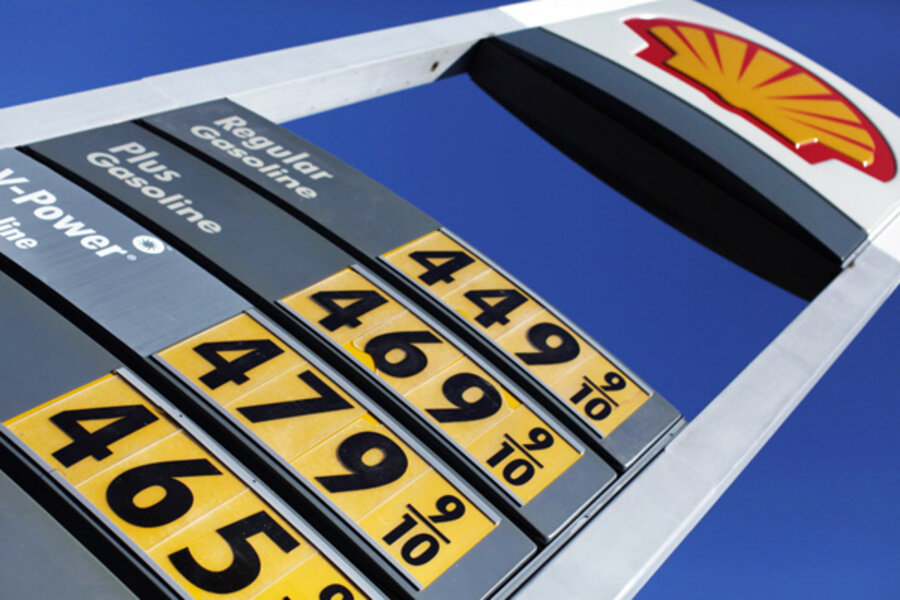As gas prices soar, Californians test life above the $4-a-gallon mark
Loading...
| Sherman Oaks, Calif.
Gas prices are giving handyman Sal Kalil a very tough time.
“I’m putting more money into my truck than into anything else in my life,” he says.
His 1995 pickup only gets about 10 miles per gallon, tethering him to work – painting, carpentry, odd jobs – close to his Pasadena home.
“I’m not eating like I usually do and am forgoing all kinds of things because of this,” Mr. Kalil says.
His predicament will be common to more and more people nationwide in the next few weeks as gas prices surge toward the $4-per-gallon mark, a psychological threshold at which analysts say consumers begin to dramatically modify their behavior.
For the moment, the average price of self-serve regular in the nation’s most populous state is 31 cents per gallon higher ($3.83) than the national average ($3.52), according to the California Energy Commission. But from Feb. 8 to 15, the price Californians paid already topped $4.10.
The result is impacting people and businesses in the Golden State in profound ways.
“We are spending $90,000 a week on gasoline for our fleet,” says Keith Lutrel, general manager of Lutrel Trucking Inc., in Bakersfield. He calculates the 60-cent rise per gallon since August has bumped up the cost to keep his fleet of 35 trucks on the road by $15,000 per week.
“It’s getting harder and harder to survive with fuel prices like these,” says his brother Rick. “Only the really big companies – 200-400 trucks – can survive nowadays,” he says. “Will this [firm] last another generation? I doubt it.”
Michael Kopilevich, owner of OnTime Limousine in Los Angeles, says high-priced gas is now burning through about 20 percent of his company’s revenue, compared with 7 to 10 percent in 2008.
“In general, everything in my life is changed in a bad way because gas prices are tied to everything … it’s just a big chain reaction,” says Mr. Kopilevich, whose firm has 12 limousines and 7 full-time drivers. To make ends meet, he says, he is deferring maintenance, vacations, and new-car purchases.
The owner of family-run Affordable Limousine Service – who requested his name not be used – says he is making ends meet by moonlighting with other companies that require chauffeur’s licenses, even making food deliveries.
“To stay in business, we have to keep cutting our prices to the bone,” he says. He wonders aloud whether competing firms are forgoing insurance payments.
“We only have three cars and we’re family owned so we can’t lay anyone off. We’re barely making enough money to pay our bills.”
From messenger services to pizza deliverers, anyone who burns fuel to get to their market is being hit hard by the high prices and trying to pass them on to their customers.
“We’re trying to get our customers to pay a surcharge, and they are screaming that they can’t pay it and will go elsewhere,” says Rick Lutrel of the family truck firm. “We are looking for ways to band together.”
The Automobile Club of Southern California meanwhile says that the price of regular fuel is 19.4 cents higher than a week ago and 51.4 cents higher than a year ago. Prices have increased 14 straight days and 26 out of the last 27, they say.
Spokeswoman Marie Montgomery told the L.A. Daily News she is optimistic that the spikes could signal an early peak in seasonal prices that might lead to a sooner decline.
“Hopefully that peak comes early,” she said. “Generally speaking we see the peak of L.A. prices in May. We started a little earlier this year and maybe we’ll peak a little earlier.”
Others say they can’t wait for a price drop any more and are changing their vacation plans.
“We usually take a big family trip, but now we’re just going to stay home and go to the beach a lot,” says Becky Chastain, playing a video game on her iPhone in the front seat of her mother’s Volvo XC 90 at a Sherman Oaks gas station.
Ms. Chastain says her mom went inside the station to pay the cashier to save the obligatory 45-cent fee for using an ATM card. She says she understands that prices are soaring because Iran announced on Monday they would stop selling oil to England and France.
“I know Iran threatened to shut the Straits of Hormuz, which is the passage for one-fifth of the world’s oil,” says Chastain. “And I’m embarrassed to say I had to get out a world map to see where that was.”





